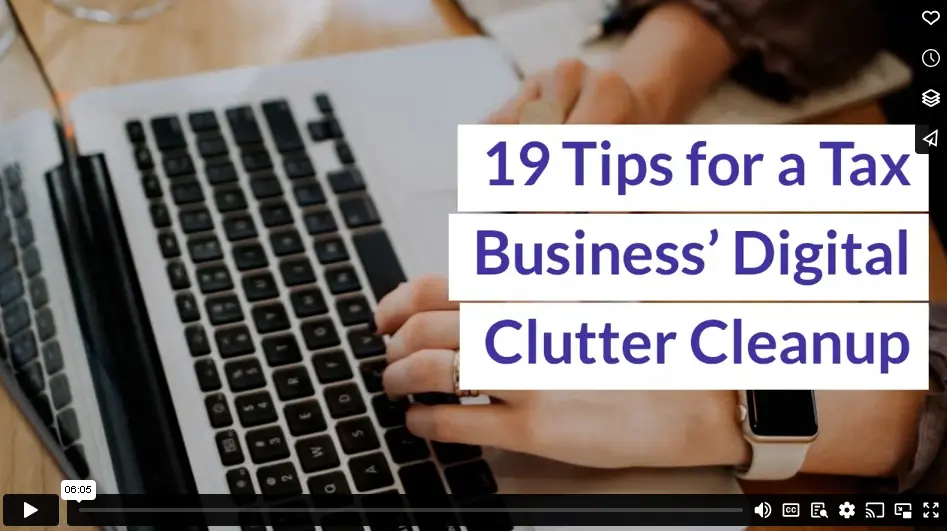As a tax prep company, digital clutter can be a real headache. From overflowing email accounts to chaotic calendars and disorganized photo libraries, it’s easy to feel overwhelmed.
The good news is setting up simple systems can make a huge difference. Below, we share some tips to help manage digital clutter and stay organized.
1. Streamline Your Social Media
Unfollow accounts that no longer interest you. Adjust your privacy settings for more control. Consider cleaning up your friends or followers list regularly. This will create a more enjoyable and less cluttered social media experience.
2. Declutter Your Email
Keeping your inbox manageable reduces stress and improves productivity. Unsubscribe from mailing lists you no longer read. Archive or delete old emails. You can use filters to automatically sort and filter incoming messages.
3. Turn Off Unnecessary Syncing
Many apps and devices sync automatically, which can create clutter. Consider turning off syncing for apps you don’t use often. Review your sync settings and only keep what’s essential. Taking these steps should help reduce app clutter on your computer.
4. Implement Efficient Document Management
Keeping documents organized is crucial. Use accounting document management software to store all your digital documents securely in one place. This reduces the need for physical storage and makes retrieving and sharing files easy.
5. Manage Your Browser Bookmarks
Over time, bookmarks can pile up and become a digital mess. Sort your bookmarks into folders and delete those you no longer need. The outcome will be a simpler, more organized browser that makes it easier to find important websites quickly.
6. Use Cloud-Based Storage
Cloud-based storage platforms help you declutter digital files and emails. At the end of the year, audit files, organize them, clean up emails, back up data, review retention policies, and set up automated rules. Train your support staff to maintain a clean digital workspace and boost productivity all year.
7. Optimize Your Calendar
Use a digital calendar to track appointments and deadlines. Color-code events for better visual organization. By setting reminders for important tasks, you can stay on top of your schedule and avoid missing important deadlines.
8. Consolidate Client Information
Managing client information can quickly become overwhelming. To keep things organized, consolidate all client data into one centralized location. You can use accounting client management software to efficiently update records, set follow-up reminders, and categorize clients by category or service type.
9. Organize Your Folder Structure
Tired of searching for documents every time you need one? A good folder system is essential. Rename any folder named “New Folder,” delete empty folders, and develop a structure everyone in your firm can follow.
10. Implement Document Naming Conventions
Adopt a consistent document naming convention for all files. This practice makes it easier to search for and retrieve documents. For example, use a format like “ClientName_TaxYear_DocumentType” (e.g., “Smith_2023_1040”).
11. Clean Up Your Downloads Folder
The downloads folder can quickly become a catch-all for various files. Regularly review and delete files you no longer need. Move important files to their appropriate folders to keep your downloads folder organized.
12. Maintain a Minimalist Desktop Background
A simple desktop background can improve productivity and reduce distractions. Choose a clean, minimalist background that doesn’t clutter your eyes or mind. This small change can have a significant impact on your focus.
13. Optimize Your Workflow with Project Management Tools
Use project management tools to track tasks, deadlines, and client projects. These can help you visualize your workflow, assign tasks, and keep everything organized in one place.
14. Keep Software Up-to-Date
Ensure all your software and applications are up-to-date. Regular updates can improve performance, fix bugs, and enhance security. Updated software also often includes new features that can help streamline your workflow.
15. Use a Client Portal
Implement a client portal for secure document exchange and communication. A client portal reduces the clutter of email attachments and provides a centralized location for clients to upload documents and communicate with your team.
16. Automate Routine Tasks
Automate repetitive tasks such as reminders for client document submissions, appointment scheduling, and email follow-ups. Automation reduces manual effort and keeps your workflow organized. Use tools like automated text messaging systems and email automation platforms.
17. Utilize Digital Signatures
Switch to digital signatures for client documents and forms. This reduces the need for physical paperwork, keeps your files organized, and speeds up the process of obtaining necessary signatures. Many accounting software solutions come with integrated digital signature features.
18. Implement Two-Factor Authentication
Improve the security of your digital workspace by implementing two-factor authentication (2FA) for all accounts. An extra layer of security helps protect against unauthorized access, reducing the risk of digital clutter caused by security breaches.
19. Conduct Regular Digital Audits
Set aside time monthly or quarterly to conduct a digital audit. Review your files, emails, and software. Delete what’s no longer needed and organize the rest. Regular audits prevent digital clutter from building up and keep your workspace efficient.
Final Thoughts
No matter how diligent you are, clutter will always find a way to pile up. Your best bet is to regularly tackle it and implement smart measures to keep it at bay. With consistent effort, you’ll see significant wins in productivity and efficiency. Declutter today and give your digital workspace a fresh start.
Video




